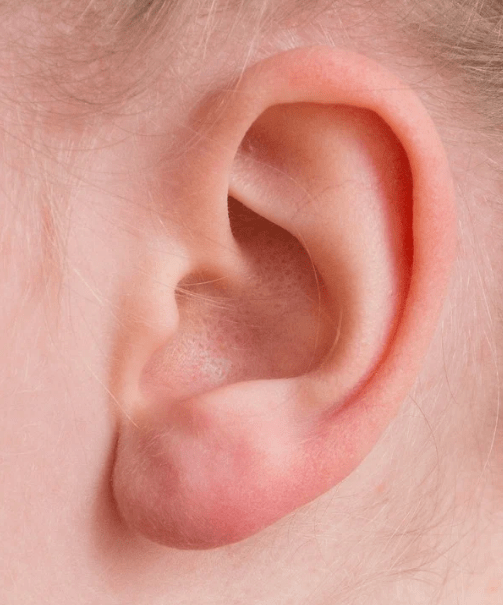Ear infections occur when one or both eustachian tubes, the tubes connecting the middle ear to the back of the throat, get swollen. The eustachian tubes allow mucus to drain from the middle ear into the throat.
Colds, throat infection, acid reflux, or allergies are the most common causes of ear infections as these conditions cause swelling in the eustachian tubes, consequently blocking the mucus from draining, allowing viruses or bacteria to grow in the mucus and creates pus which accumulates in the middle ear.
The most common type of ear infection is acute otitis media (AOM). This is often accompanied by pain in the ear due to the infection, swelling, and the trapped fluid behind the eardrum.
Another type of ear infection is otitis media with effusion (OME). This happens when the fluid in the ear retains even after the infection is over. This type of infection may not have any symptoms, but a doctor can detect this fluid. This is why it is important to always consult with your pediatrician. The severe type of ear infection is chronic otitis media with effusion (COME). This happens when OME persists. COME results in frequent ear infections and, worst could result in hearing loss.
Inner ear infections are something you, parents, should be alarmed about, given that these infections are one of the primary reasons for antibiotic administration and surgery among children than any other childhood ailment. If these ear infections remain untreated, they can result in hearing, developmental, and mental complications.
Reasons Why Kids are More Prone to Ear Infections
Children, particularly between 0 to 4 years old, get more ear infections as compared to adults. Ear infections are also said to occur more in boys than girls, and these infections are very common during winter and cold months when a lot of people get upper respiratory tract infections or colds.
For this reason, you must be careful when taking your child out or bringing them to travel during the cold months. During winter, it is recommended that they stay at home as much as possible. Let them play indoors and enjoy a cup of hot chocolate drink once in a while.
There are also several reasons for ear infections and why kids are more prone to ear infections.
- Children have shorter, more horizontal eustachian tubes, making bacteria and viruses easily enter the middle ear.
- Children’s eustachian tubes are also narrower than adults, and these narrow tubes can easily get blocked.
- The adenoids, or the gland-like structures at the back of the throat, of children are larger. This can also interfere with the opening of the eustachian tubes.
- Another reason for ear infection among kids is because your child’s immune system may still not be strong enough to fight off these bacteria and viruses.
- Secondhand smoke, bottle-feeding, and being around other kids in childcare can also increase children’s risk of ear infection.
- Researchers have also reported that ear infections may be hereditary. Some children are more susceptible to ear infections due to their genetic makeup. For instance, it was observed that identical twins are more vulnerable to ear infections than fraternal twins.
Although ear infections are not contagious, the colds causing them can still be transmitted. For this reason, it is ideal to have your child consulted with your pediatrician should they experience a cold. Do not dismiss it for an ordinary cold. It is always better to be sure.
Treating Ear Infections
In addressing ear infections, health care providers typically consider several factors, such as:
- the type and severity of the ear infection
- how often the child has ear infections
- how long this infection has lasted
- the child’s age and any risk factors
- whether the infection affects hearing
These factors affect the treatment options made for children. These ear infections often clear on their own, so doctors would first observe the situation. Kids with ear infections would just be given pain relievers for the earache. Antibiotics are not always used to treat ear infections for several reasons.
- Antibiotics do not address infection caused by a virus
- Antibiotics do not eliminate middle ear fluid
- Antibiotics have side effects
- Antibiotics only have minimal effect and do not relieve pain in the first 24 hours
- Overuse of antibiotics may result in antibiotic-resistant bacteria, which are much harder to treat.
Children with recurrent infections and lasting hearing loss or speech delay may require an ear tube surgery, where an ear, nose, and throat doctor would insert tympanostomy tubes to drain the fluid from the middle ear. This helps equalize the pressure in the ear.
Signs of Ear Infection in Kids
The majority of ear infections happen even before a child learns to talk. If they are not able to say that their ear hurts, here are signs of ear infection you can note:
- Tugging or pulling at the ear(s)
- Fussiness and crying
- Trouble sleeping
- Fever (especially in infants and younger children)
- Fluid draining from the ear
- Clumsiness or problems with balance
- Trouble hearing or responding to quiet sounds
If you ever observe these signs of an ear infection on your child, immediately consult with a pediatrician.



